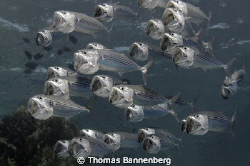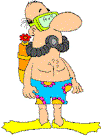|
|
|
Underwater Photo Location: Shagra Bay (north)
How Hot is this Dive Site? click a star to rate it
The Indian mackerel is found in warm shallow waters along the coasts of the Indian and Western Pacific oceans. Its range extends from the Red Sea and East Africa in the west to Indonesia in the east, and from China and the Ryukyu Islands in the north to Australia, Melanesia and Samoa in the south. It has also entered the Mediterranean Sea through the Suez Canal. [Wikipedia] Facts about Shagra Bay (north) It is in Egypt It is in Egypt- Shagra Bay (north) is in the Red Sea.
- The typical depth is 0-10 Metres 0-30 Feet.
- The typical visibility is 3-10 Metres 10-30 Feet.
| Dive types |  |
| Marine Life |   |
| Photo facilities |  |
 by Thomas BannenbergIndian mackerel (Rastrelliger kanagurta)
NIKON D7000 in a Seacam "Prelude" uw housing, @35mm
Settings: f8, 1/125, ISO 100
 Share your knowledge... Share your knowledge...
|